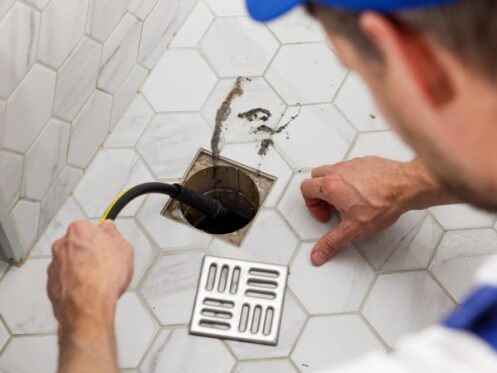As you wash dishes, run the bath, or turn on the bathroom tap, water enters your drain and flows away from your home. However, this dirty sewer water doesn’t just disappear. Instead, it begins a long journey through your pipes to its final destination in the Denver sewer system or your septic tank.
Explore each step of the wastewater journey to understand where sewer water goes once it enters your drain. From the P-trap to the final treatment facility, every pipe and component plays a key role in helping water return to the environment.
Where Do Household Drains Lead?
Wastewater ultimately ends up in your city sewer system or a private septic tank, but first, it has to pass through several key components before it exits your home. From the P-trap to the vent pipe, discover where drain water goes once it leaves your home.
P-traps
A P-trap is a curved section of pipe located underneath your sink, bathtub, shower, and other fixtures. As water flows into the drain, it first passes through the P-trap, where a small amount gets trapped in the curve. By capturing this water, the P-trap creates a barrier that prevents sewer gases from entering your home.
Drain pipes
After passing through the P-trap, wastewater flows into the drain pipes. These pipes angle slightly downward so gravity can assist in moving water through the system. Wastewater travels through the pipes into larger drain lines and eventually flows into the main sewer line. Vent
As wastewater flows through your pipes, it relies on the vent pipes to equalize pressure within the system. Vent pipes run from your plumbing through the roof of your house, where they release sewer gases and allow air to enter the system. Without this venting, your drain pipes would become clogged and slow, creating a vacuum that prevents water from draining.
How Does Water Exit My House?
After water enters the drain and flows through the pipes, it travels out of your home through the lateral connection. The lateral connection carries this water to the city’s main sewer line or a private septic system, depending on your local sewer setup.
Lateral connection
The lateral connection pipe carries wastewater from your home to the main sewer line or septic system. In a municipal system, it connects your home’s pipes to the city’s public sewer system beneath the street. In a septic system, wastewater from your home flows to your septic tank, where solids are removed and liquid waste is sent into the drain field.
Main sewer line
Cities or towns with public sewer service have main sewer lines underneath the streets or alleys. Wastewater from homes and buildings within the area is sent to this pipe via lateral connections and then flows to the municipal treatment plant or disposal system.
Where Does Sewer Water Eventually End Up?
Once wastewater leaves your home, you may be wondering where the sewer leads. Wastewater doesn’t just stop at your city’s main sewer line — it travels through this pipe to a treatment facility, where it undergoes filtration and final disposal.
Treatment facilities for wastewater
Once wastewater enters the main sewer line, it travels to a sewage treatment plant or wastewater treatment facility. It then undergoes a two to three-step filtration and treatment process to remove chemicals, contaminants, and harmful pathogens. The process is as follows:
- Primary treatment: While large solids settle at the bottom, grease and oil float to the top where they’re skimmed off.
- Secondary treatment: The facility uses bacteria to break down any remaining organic matter.
- Tertiary treatment: If necessary, the water undergoes additional filtration, disinfection, and UV treatments to make sure it’s safe for release.
After the water undergoes these treatments, the facility releases it into nearby bodies of water such as rivers, lakes, or oceans. Depending on where you live in the Greater Denver area, the city may instead use the water for irrigation, industrial uses, or other environmental applications.
Need Help Maintaining Your Sewer Line? Contact the Team of Plumbers at High 5!
If clogs, backups, or broken pipes are stopping sewer water from flowing properly, contact the team at High 5 Plumbing, Heating, Cooling, and Electric. Our expert plumbers offer comprehensive sewer maintenance and repair services to help restore your plumbing system and get wastewater moving again.
True to our core values, we’re upfront about pricing and work hard to earn our customers’ trust and satisfaction. Whether you require a quick fix or complete system inspection, you can count on our team to provide fast, reliable service and lasting results. Contact us today to schedule your sewer line appointment in the Greater Denver Metro Area.
Frequently Asked Questions
What happens when sewer water enters a septic tank?
When sewer water enters a septic tank, heavy solids sink to the bottom and create a sludge, while fats, oils, and grease rise to the top. Bacteria break down the sludge, while the remaining liquid flows to the drain field for further treatment and filtration.
Is it possible to recycle wastewater into drinking water?
Yes. Wastewater can undergo potable water reuse, which recycles it into safe drinking water. This process involves advanced treatment methods like filtration, reverse osmosis, and UV disinfection to remove harmful contaminants from the water. Many areas with limited water availability use this process to supplement their supply.
What is wastewater?
Wastewater is water from homes, businesses, industrial facilities, or storm runoff that is no longer clean enough for reuse. This includes water from showers, baths, sinks, and appliances in your home. Before someone can use this water again, it must travel to a treatment facility for filtration and purification.

